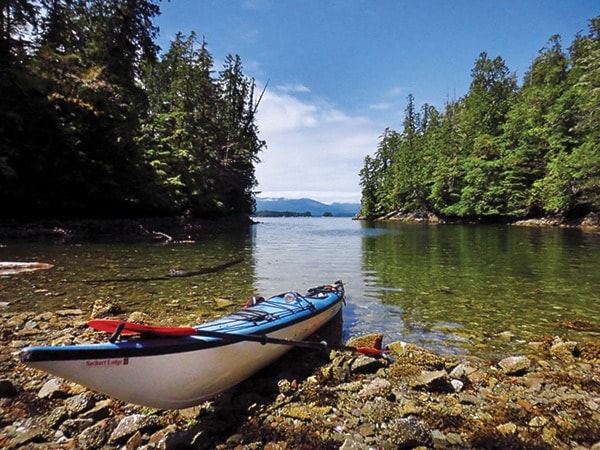“Are you going to come over and say hi?” asks a woman wearing yellow rubber boots, standing on the shore with two children.
Surprised to see someone, I hesitate for a moment, then coyly reply “maybe,” as I pull my kayak onto the sandy, secluded beach. But there’s only one thing on my mind — finding a place to pee.
“Are you alone?” the woman asks once I return from the closest patch of trees.
“Yes,” I reply, digging through my backpack for a sandwich.
“Are you a kayaker?” she asks with a curious smile.
“Not really, but I’m trying to be,” I say, then explain my one-day plan for exploring this wild landscape on B.C.’s spectacular coast.
I had just spent two hours peacefully paddling through the Pinkerton Islands, located in the Barkley Sound adjacent to the Broken Group Islands nestled between Ucluelet and Bamfield on the rugged West Coast of Vancouver Island.
The islands offer the perfect escape from the world when life becomes too hectic. After a short paddle from Sechart Lodge where I’m spending two nights, I’m greeted by a chorus of song birds the moment I enter the narrow passages that weave through the tiny islands blanketed in trees. The water is calm, the only ripple coming from my paddle.
A bald eagle sits in a nearby tree, looking for its next meal while a small black bear lurks on a nearby shore. This is nature at its finest.
By noon the clouds that blanket the region every morning begin to clear as I make my way west towards a few of the Broken Group Islands.
The broken group belong to the Pacific Rim National Park Reserve and consist of more than 100 islands, islets and rocky outcrops scattered in the centre of the Barkley Sound where harbour seals, gray whales and harbour porpoises frequent the waters year round.
Consisting of coastal rainforests surrounded by sand fringed bays, quiet coves and sheltered waterways filled with an assortment of sea creatures clinging to rocky edges, the islands have become an internationally known destination for paddlers and boaters in search of a true West Coast experience.
Use of the islands is only permitted to those with boats, canoes or kayaks. Designated camping is allowed in seven areas, but this time I opted for delicious home-cooked meals and hot showers offered at Sechart Lodge.
Due to the short distances between islands and the sheltered waters, the broken group is a great place to gain experience for those who are new to kayaking, such as myself. I had been in a kayak less than 10 times when I decided to embark upon this solo adventure through some of the best scenery the West Coast has to offer, but felt confident I had enough skills to safely navigate through the waters for a day and find my way back to the lodge. Still, I couldn’t help but feel a bit nervous as I slid into my kayak and paddled away from the dock on my own.
Being on the ocean in a kayak is an experience like no other. I can feel the coolness and every movement of the water while observing the depth of sea life around me. Staying close to the shoreline, I meander into secluded little coves with sparkling emerald water and rocky beaches where I pull my kayak on shore for an afternoon siesta. I feel like an explorer, knowing I have the freedom to paddle wherever I please.
Victoria residents Rex Frost, 68 and Bob George, 72, have been coming to the islands for the last 25 years to kayak and camp for several nights. Originally there were 11 people in their crew, but the group has dwindled to just the two of them for the last five years.
The pair plan to continue their tradition for as long as they possibly can.
“The others said we’re too old to be doing this. I’ll be doing it until the McCall brothers come to burry us out at sea,” said Frost as he stood on the dock at the Sechart Lodge day use area, removing gear from his kayak after four nights of camping on the islands.
“It’s the beautiful scenery, the tranquility, being able to sleep outdoors. You’re gliding along the water. When we’re on the water it’s very calming and quiet. There’s no extraneous noise.”
After six hours on the water and four stops on various islands, I make my way back to Sechart Lodge, but the ocean doesn’t want me to leave. Arms aching and beads of sweat dripping down my face, every stroke is a challenge as I cross the last stretch of open water, the lodge clearly in sight.
“Almost there,” I tell myself as motivation to keep going, but I have no choice.
Back at the lodge, the common area is filled with chatter as kayakers excitedly share their adventures on the water, pointing to where they’ve been on a large map on the wall. It’s just another day of paddling in paradise.
